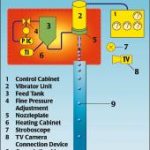Since handling many active agents in their pure form causes various problems, microencapsulation is used to ensure better properties in the product. The patented Brace processes permit a very wide range of materials to be encapsulated in monodisperse microspheres or microcapsules in a diameter range from 50 to 6000 µm and with a very narrow size distribution. The capsules or spheres can be used for many applications in the chemical, pharmaceutical and food industries.
Dr. Thorsten Brandau
Most technically or industrially available products are handled as grains, flakes, blocks or powders. This granulometry results in numerous problems, especially when active agents need to be handled. Not only is the application itself in many cases fraught with difficulties, e.g. due to instabilities of the active agent in air, but dosage with potent or expensive agents or handling with oily ones also leads to expensive machinery with many accompanying drawbacks.
Microencapsulation
These problems can be solved by microencapsulation with Brace microspheres and microcapsules. The microspheres are solid spheres with a matrix-encapsulated active agent, while the microcapsules consist of a solid shell with a liquid or solidificated core (Fig. 1).
The main difference between these two types of microgranule concerns the release profile. While microspheres usually have diffusion-controlled release profiles with a permanent release rate which is kinetically controlled by the particle size, microcapsules expel their content in a single high burst as the shell breaks (Fig. 2).
Process description
The patented Brace processes for producing microspheres and microcapsules are basically vibrating nozzle processes. These processes produce particles with monomodal grain size distributions and a single sharp maximum. dmin/dmax values of less than 1.10, 1.05 or even 1.01 are common among spherical granules produced with the microsphere units. It is possible to obtain microspheres or microcapsules in a diameter range from 50 to 6000 µm; larger or smaller particles are achievable with special nozzles. A wide range of shell materials can be used with this highly scalable process. The processes combine low space and energy consumption with high throughput and extreme flexibility regarding the materials to be used. All installations can be customer-tailored to meet essential requirements like GMP/GLP and FDA as well as pharmaceutical, food, nuclear, chemical and other industrial standards.
The process itself can be described schematically as follows (Fig. 3): a liquid feed is pumped from a feed tank (3) to the nozzle head (5), where the vibrating device (2) induces the break-up of the flow into uniform droplets. These are formed into spheres by the surface tension of the feed. The droplets are solidificated as they fall (9). This can be brought about by cooling, chemical reaction or drying, depending on the materials and/or coagulation system used. The head of the microsphere unit can be placed in a heating chamber (6) and either a stroboscopic lamp or a camera set for remote control is used for visual control of the process. The electronic cabinet (1) controls the microsphere unit and can be integrated into existing control systems.
Materials and properties
There are few limitations on the materials that can be used for the microsphere processes. They must be liquid, their viscosity must be less than 10 000 mPa·s, emulsions and dispersions must be stable for the complete duration of the process, dispersed particles should have a diameter that is less than 1/4 of the nozzle size and presolidification should be a fast process to prevent the particles from being deformed.
The resulting list of chemicals is very long. Alginates, gelatines, cellulose sulphates, waxes/thermoplastics, oxides, polyamide and polystyrene are only a few of the potential materials. The suitable active agents depend on the encapsulation technique. With matrix encapsulation (microspheres), the active agent can be dispersed, dissolved or emulsified into the shell material. With microcapsules, the core material can consist of a liquid like a solution, an emulsion, a dispersion or a fusion/melt. The only restriction is that this core material should not react with the shell material (and pos-sibly weaken it).
After production, the microspheres can be treated with any available technology, including drying with all standard dryers, calcining, sintering, coating, impregnating, sorting, chemical treatment, etc.
Types of installation
All microsphere units are tailored to the specific needs of each customer. Depending on the application, they are built to conform to GMP/GLP, FDA, CIP or WIP as continuous or batch installations, either fully or semi-automatic. They can be adapted to existing production facilities and scaled from laboratory up to bulk production. Materials such as stainless steel, glass or plastic are used. The production capacity of each installation ranges from about 10 ml/h to more than 1000 l/h.
The actual througput and the number of the microspheres depend on the nozzle diameter. With a 500 µm nozzle for example, a throughput of 11 l/h with about 8000 microspheres per second with a 1 mm diameter can be produced. With a 200 µm nozzle (resulting in about 400 µm microspheres), the throughput is only around 2.8 l/h but with 30 000 microspheres per second.
Examples
Brace processes are widely used in the chemical, pharmaceutical and food industries. Waxes, for example, are common in cosmetic and dental applications or as catalysts with active ingredients. Agar agar is used to encapsulate oils and other volatile ingredients for cosmetic applications, while gelatines and alginates serve to encapsulate oils, fragrances and flavours for food technology applications. Polymer beads are used in combinatorical synthesis because the Brace process produces monomodal grains of high-quality polystyrene microspheres with defined binding capacities. In the pharmaceutical industry, the Brace process is employed to encapsulate active agents either against destructive forces in the digestive system or as taste masks for very bitter materials. The adjustable size of the microspheres permits defined release profiles to be produced. The chemical and petrochemical industries use catalyst carriers and grinding balls to obtain maximum performance and low in-process wear and tear.
cpp 433
Share:









